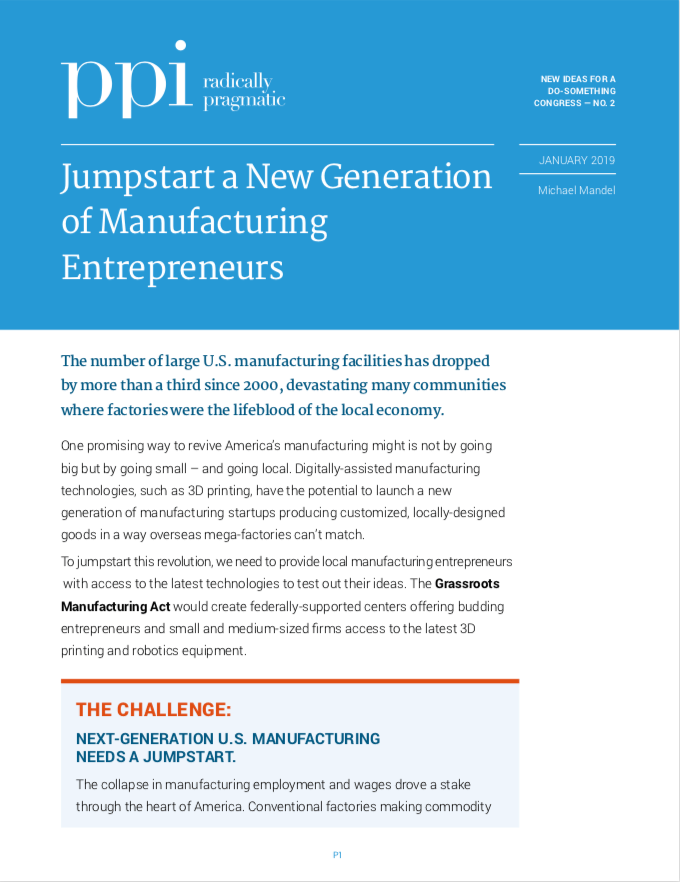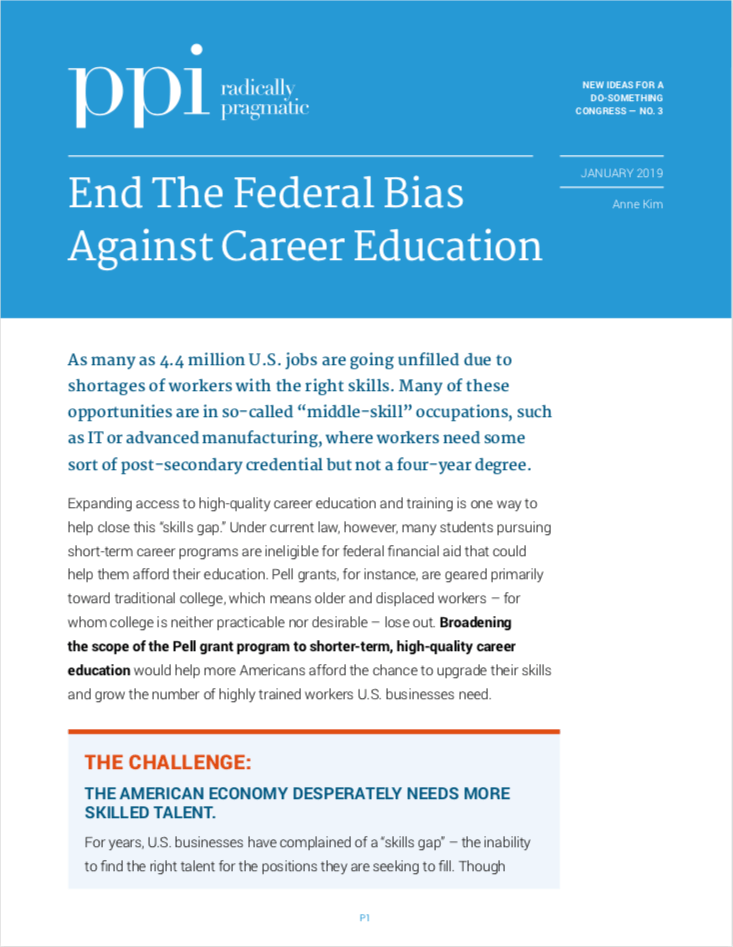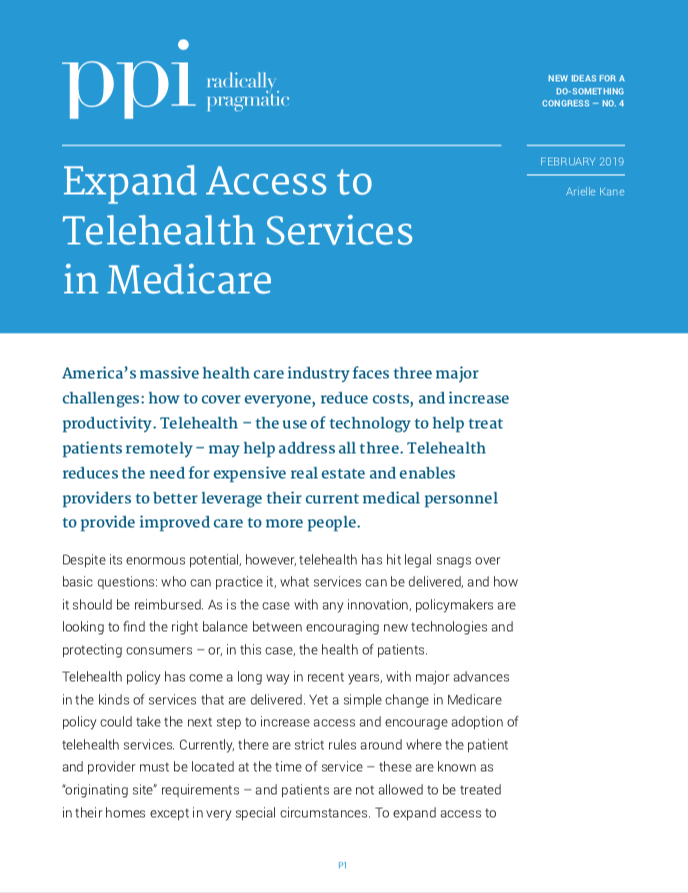Regulation plays a critical role in refereeing competition in a free market economy. But there’s a problem: Each year, Congress piles new rules upon old, creating a thick sludge of regulations – some obsolete, repetitive, and even contradictory – that weighs down citizens and businesses. In 2017, the Code of Federal Regulations swelled to a record 186,374 pages, up 19 percent from just a decade before.
The steady accumulation of regulations raises compliance and opportunity costs for businesses, especially small enterprises, putting obstacles in the way of economic innovation. Dozens of agencies in Washington issue new rules, but not one is dedicated to retiring old ones. To fill this institutional vacuum, PPI proposes a Regulatory Improvement Commission (RIC), modeled on the highly successful Defense Base Realignment and Closure (BRAC) process for closing obsolete military installations. Like the BRAC process, the proposed RIC would examine old rules and present Congress with a package of recommendations for an up-or-down vote to eliminate or modify outdated rules.
THE CHALLENGE: REGULATORY ACCUMULATION DAMPENS AMERICA’S ECONOMIC VITALITY
Wise regulation is essential to facilitate market competition, protect public health and safety, and keep powerful economic actors honest. But as PPI has pointed out in a series of reports, even if any particular regulation is defensible, the sheer accumulation of rules over time can dampen economic vitality (1). New regulations can interact with old ones in unintended ways, and business owners end up spending more time trying to navigate and comply with proliferating rules rather than on growing their companies.
- Federal regulations hardly ever die, resulting in a dense thicket of rules that raise costs for America’s entrepreneurs and economy.
As shown in Figure 1, the Code of Federal Regulations has steadily grown in size over time, swelling to a record 186,374 pages in 2017 (2). Because the extent of regulation can be difficult to measure, the Code of Federal Regulations’ size is commonly used to provide a sense of the scope of regulations businesses and consumers must comply with. Measured another way, the Federal Register (where the federal government prints new rules) published 61,950 pages in 2017 alone, including proposed rules, final rules, and notices.
Spread across every sector, regulatory accumulation acts as a drag on the economy. One often-cited 2010 study for the Small Business Administration placed just the direct cost of compliance with all federal regulations at $1.7 trillion in 2008, or $15,584 per household (3). A 2012 consulting study for the Manufacturers Alliance for Productivity and Innovation estimated the cumulative cost of major regulations for manufacturers to be $164 billion in 2011 (in constant dollars), double the cost just 10 years earlier. More recently, a 2017 National Small Business Association survey estimated that the average small business owner spends at least $12,000 every year on compliance, with nearly one in three spending more than 80 hours every year dealing with federal regulation (4).
The Trump Administration’s “2-for-1” approach to deregulation fails to distinguish between vital rules and those that tax innovation and growth.
- President Trump frequently brags about his efforts to provide business with regulatory relief, but his 2017 executive order requiring the elimination of two regulations for each new regulation is the wrong approach. It raises the bar for issuing new regulations without creating a rigorous mechanism for pruning old ones (5).
In addition, Trump’s 2-for-1 scheme fails to distinguish between the kinds of regulations that are reasonable for public health and economic stability or would enhance market competition and those that might be unnecessary or harmful to innovation and growth. Setting aside its conceptual flaws, Trump’s approach has so far not had much practical effect either. According to a Brookings Institute analysis, the Administration’s approach to regulation has largely been one of inaction, and the most consequential “deregulatory” maneuvers have actually been undertaken by the GOP Congress through the wholesale legislative reversal of important Obama-era rules, such as on environmental protection (6). Neither outcome leads to the sort of effective regulatory framework our economy needs.
THE GOAL: IMPROVE THE REGULATORY ENVIRONMENT TO UNLOCK ENTREPRENEURIAL GROWTH
Washington needs a mechanism for systematically eliminating regulatory obstacles to economic innovation and entrepreneurship while protecting public safety and ensuring fair competition. Improving the regulatory climate would help inventors and entrepreneurs spend less time and resources on regulatory compliance and focus instead on delivering goods and services and growing their enterprises. A smarter regulatory regime would also realize savings for taxpayers, as less money would need to be spent on enforcement.
While Democrats see the value in responsible regulation that has an important societal function, Republicans take the general view that less regulation is always preferred to more, and that too many regulations of any kind hamper economic growth and potential business investment. These differences in opinion result in incompatible ideas for what regulatory reform should look like.
The answer to outdated, conflicting, or costly rules isn’t deregulation, but the constant updating, streamlining, and improving of our regulatory system. PPI’s proposal for a Regulatory Improvement Commission (RIC) bridges the stale, gridlocked debate on the merits of regulation between Democrats and Republicans, presenting a measured and bipartisan mechanism for improving the regulatory environment to catalyze innovation while also protecting public interests. The RIC would fill an institutional vacuum in regulation policy by creating a mechanism for the periodic clearing out of obsolete rules. Importantly, the RIC has no mechanism by which it can inhibit policymakers’ ability to create critical new rules to address threats to competition or public health and safety. Rather, the RIC would be designed to address only existing regulations that have accumulated over time and are now obsolete.
THE PLAN: ESTABLISH REGULATORY IMPROVEMENT COMMISSION TO DEAL PERIODICALLY WITH THE BUILD-UP OF OLD RULES
Washington has dozens of agencies that issue new rules, but not one institution dedicated to streamlining the accumulated body of regulations. To fill that vacuum, Congress should set up a regulatory version of the Defense Base Realignment and Closure Commission (BRAC), which has resulted in the successful closure of more than 350 obsolete installations since the late 1980s. That panel offers a rare example of bipartisan success in accomplishing a politically difficult mission – shutting down old military bases that the Pentagon deemed no longer necessary, but which had influential constituencies in communities around the country.
The RIC would be an independent commission of eight members, appointed by the President and Congress, with regulatory expertise across industry and government. It would meet as authorized by Congress to review and, following a public comment period of 60 days, draw up a list of 15 to 20 rules for elimination or modification. The package would be sent to Congress for an up-or-down vote, and the RIC would be disbanded. If the proposed changes pass Congress, they would go to the president’s desk for signature or veto. The RIC would need to be re-authorized each time Congress would like to repeat this process. Such continued re-authorization is important, as it provides an inexpensive method to solve the problem of regulatory accumulation compared to a standing committee and avoids the creation of a new government bureaucracy.
In 2015, bipartisan groups of lawmakers introduced bills in the House and Senate to establish a Regulatory Improvement Commission based on the BRAC model. House cosponsors included Mick Mulvaney (R-SC), now acting White House Chief of Staff, and Kyrsten Sinema (D-AZ), now a Democratic Senator from Arizona. Unfortunately, the incoming Trump administration ignored the bipartisan RIC bills in favor of anti-regulation bills supported only by Republicans.
The RIC offers an alternative to the witless binary approach to regulation poised by extreme partisans on both ends of the spectrum. Obviously, America’s massive and complex economy needs smart regulation to function properly, and we need institutions charged with constantly improving our regulatory environment, rather than simply piling new rules atop old ones.
In this way, the RIC would fill a vacuum in Washington for a politically viable regulatory improvement mechanism that can inspire confidence across our partisan and ideological divides. And it would create a court of appeal where anyone—business, consumers, labor, civic groups—could challenge existing rules and propose changes.
[gview file=”https://www.progressivepolicy.org/wp-content/uploads/2019/03/PPI_Break-Americas-Regulatory-Log-jam_V4-1.pdf” title=”PPI_Break America’s Regulatory Log-jam_V4 (1)”]
ENDNOTES
1) Michael Mandel, “A Progressive Approach to Regulation”, Progressive Policy Institute, February 2011: https://www.progressivepolicy.org/2011/02/reviving-jobsand-innovation-a-progressive-approach-to-improving-regulation/
2) Federal Register: The Daily Journal of the United States Government, “Federal Register and CFR Publication Statistics – Aggregated Charts (XLS)”: https://www.federalregister.gov/reader-aids/understanding-the-federal-register/federal-register-statistics
3) Small Business Administration, “The Impact of Regulatory Costs on Small Firms,” September 2010: https://www.sba.gov/sites/default/files/The%20Impact%20of%20Regulatory%20Costs%20on%20Small%20Firms%20(Full).pdf.
4) “2017 NSBA Small Business Regulations Survey,” National Small Business Association, 2017. https://www.nsba.biz/wp-content/uploads/2017/01/Regulatory-Survey-2017.pdf
5) “Reducing Regulation and Controlling Regulatory Costs,” Executive Order 13771, Federal Register, January 30, 2017. https://www.federalregister.gov/documents/2017/02/03/2017-02451/reducing-regulation-and-controlling-regulatory-costs
6) Jennifer Erin Brown, Joelle Saad-Lessler and Diane Oakley, “Retirement in America: Out of Reach for Working Americans?” National Institute on Retirement Security, September 2018, https://www.nirsonline.org/wp-content/uploads/2018/09/FINAL-Report-.pdf.
7) Connor Raso, “How has Trump’s deregulatory order worked in practice?,” Brookings Institute, September 6, 2018. https://www.brookings.edu/research/how-has-trumps-deregulatory-order-worked-in-practice/.













